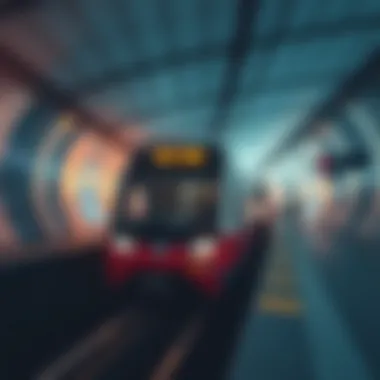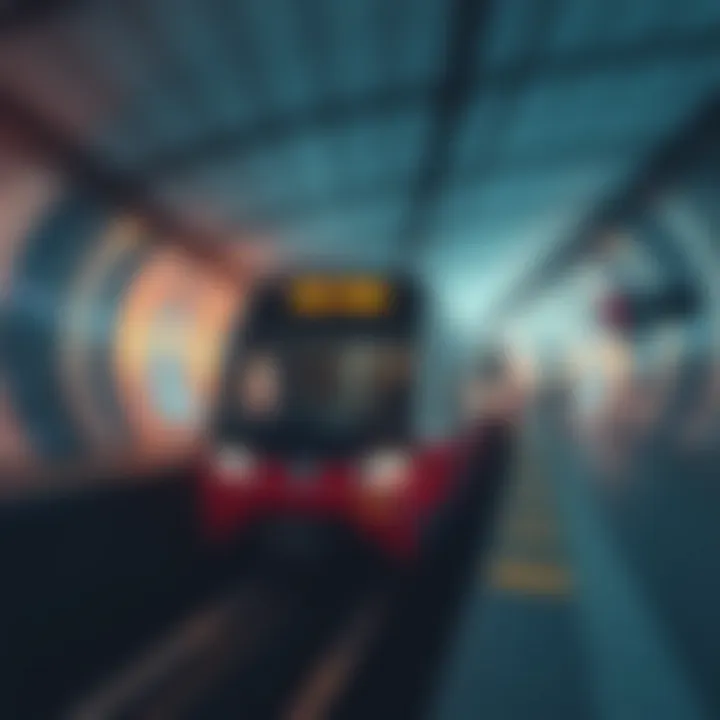Comprehensive Guide to UAE Metro Timing and Scheduling


Intro
The United Arab Emirates has transformed over the past few decades into a bustling hub of commerce and tourism. Among the key elements facilitating this growth is the metro system, particularly in cities like Dubai and Abu Dhabi. Understanding the metro timings is not only vital for daily commuters but also for investors and real estate professionals. The efficiency of the metro can affect property values, accessibility to businesses, and overall urban experience.
For many residents and visitors, knowing when to hop on that train can make the difference between a swift, smooth ride or being caught in the hustle and bustle of rush hour. Moreover, as more people flock to the UAE in search of business opportunities or a new life, the metro system’s timing becomes increasingly relevant.
This article will dissect various components surrounding metro timing in the UAE, focusing particularly on peak hours, off-peak periods, and their implications for both daily life and investment opportunities. By the end of this guide, you will be richly informed on how these factors interplay, aiding in informed decisions whether you're buying a home, managing a property, or planning a commute.
Prolusion to the UAE Metro System
The UAE Metro system stands as a vital vein pumping life into the urban landscape of cities like Dubai and Abu Dhabi. It’s not merely a means of transport; it embodies a commitment to modernity and efficiency that aligns with the UAE's rapid development. Understanding the metro system's nuances, including its timing and scheduling, is essential for anyone navigating these bustling environments—be it locals commuting for work or tourists exploring the sights.
Overview of Metro Infrastructure
When delving into the infrastructure of the metro system, one must appreciate the sheer scale and sophistication that underpins it. The Dubai Metro, for instance, boasts an extensive network with over 75 kilometers of track, featuring two principal lines: the Red and Green lines. These lines connect key districts, housing some of the UAE's most cherished landmarks.
The stations are built with high safety standards, combining aesthetics with functionality. Stations often showcase innovative designs that reflect Emirati heritage while incorporating modern materials. The fully automated nature of these trains eliminates the need for onboard conductors, resulting in a quieter and smoother experience for daily commuters.
In a bustling city where traffic congestion can be a hassle, the metro stands out as a reliable alternative. With up to 66 trains in operation during peak hours, it certainly eases the burden on the roads.
Additionally, the infrastructure includes facilities for people with disabilities, ensuring accessibility for all. Amenities such as elevators, signage in multiple languages, and special seating sections highlight the system's inclusivity.
Significance of Metro Timing
Timing in the metro context is not just about punctuality; it’s a linchpin for efficient urban transport. The UAE Metro operates under a meticulously planned schedule that reflects the rhythm of city life. Knowing these timings is crucial for several reasons.
Firstly, understanding metro timing helps in planning daily commutes. The difference between riding during peak hours versus off-peak can significantly impact travel time. During rush hours, trains can be packed tighter than a can of sardines, while off-peak travel often offers a much more spacious ride.
Secondly, commuters have to consider the operational hours to avoid being caught unawares. The metro typically runs from 6 AM to midnight on weekdays, but these times fluctuate on weekends and public holidays, which can leave unprepared travelers high and dry.
Lastly, timing also plays a role in the larger picture of urban development and real estate. Proximity to metro stations can enhance property values, and these values can fluctuate based on service availability. Understanding how these timings affect accessibility allows investors and homebuyers to make more informed decisions.
"In the dynamic urban tapestry of the UAE, the metro's timing emerges as a critical element that significantly influences both daily life and long-term investments.”
In sum, grasping the essence of the UAE Metro system, from infrastructure to timing, is integral for anyone wishing to navigate the ever-buzzing metropolis effectively. Each component of the system is interlinked, and understanding these connections is the first step to mastering urban travel in the UAE.
Metro Operating Hours
Understanding the metro operating hours in the UAE is essential for anyone seeking to navigate this expansive transit system efficiently. The timing of metro services plays a pivotal role in managing passenger flow, ensuring that commuters can travel during peak hours and off-peak times without a hitch. By getting a handle on the operating hours, residents and visitors alike can plan their journeys effectively, avoiding unnecessary delays or crowded trains.
Moreover, the specific operating hours have direct implications for businesses and real estate, as areas with easy access to metro stations can become more desirable. This accessibility makes the metro a catalyst for economic growth and investment opportunities. In this segment, we will delve into various aspects of the metro's operating hours, breaking it down into weekday schedules, weekend schedules, and adjustments for public holidays.
Weekday Schedule
The weekday schedule for the metro operates under a structured timeline that caters to the bustling rhythm of city life. Typically, trains commence operations early in the morning, around 5 AM, and run until midnight. Notably, during the morning rush hour, which generally spans from 7 AM to 9 AM, the frequency of trains increases to accommodate a surge in commuters making their way to work or school. The evening peak runs from around 5 PM to 8 PM, reflecting a similar pattern.
- Morning Rush: Expect trains every 5-7 minutes.
- Midday: Service intervals usually extend to every 10-15 minutes.
- Evening Peak: Trains return to 5-7 minute intervals.
This well-planned schedule is not only beneficial for daily commuters but also ensures that tourists can explore the city efficiently without worrying about delays. Being aware of the weekday timetable can significantly enhance one’s experience with the metro system.
Weekend Schedule
When it comes to the weekend, the metro generally runs on a different clock. Although service begins at the same time as weekdays, typically around 5 AM, the frequency of trains during off-peak hours slows down. On Fridays and Saturdays, it's common to see trains arriving every 10-15 minutes, allowing more flexibility for weekend activities and outings. This adjustment is crucial, as weekends tend to attract a varied crowd, from families enjoying leisure activities to young adults heading out for social events.


- Fridays and Saturdays:
- Early Morning: Every 10-15 minutes.
- Afternoon to Evening: Trains can be every 7-10 minutes, especially during popular event timings.
Understanding this schedule aids travelers in maximizing their weekend plans without the stress of overcrowding, making it easier to hit key attractions and entertainment venues.
Public Holidays Adjustments
Public holidays in the UAE often entail special adjustments to metro services. The metro authorities aim to accommodate higher passenger volumes during such occasions, where numerous people take to transit to partake in festivities or family gatherings. Trains are typically scheduled to operate earlier in the morning and extend later into the night, depending on the holiday.
Important Note: Public holiday schedules can vary widely, often based on cultural norms and expected passenger traffic levels. It is advisable to check the official metro website or local news outlets for detailed updates as holidays approach.
Such adjustments are crucial in providing consistent service and reinforcing the metro as a reliable mode of transport. Keeping an eye on these changes can prevent any frustrating surprises during your travels.
Frequency of Service
The frequency of service is a crucial pillar of the UAE Metro system, defining how accessible and convenient the metro is for users. Whether someone is commuting to work or embarking on a leisurely outing, understanding train frequency can significantly affect travel plans. This section explores how often trains run and the various factors that influence this key aspect of metro operations.
Trains Per Hour
In the UAE Metro system, the frequency of trains is structured to accommodate a diverse range of passengers. During peak hours, commuters can expect trains to arrive every few minutes, often around every 2–5 minutes depending on the line and direction. This prompt service is critical for those rushing to meetings or catching flights at the Dubai International Airport.
Conversely, during off-peak hours, train intervals can lengthen to about 7–10 minutes. This adjustment helps streamline the operations while ensuring the metro remains a viable option throughout the day.
To give you a clearer picture, here is a breakdown of operational frequency:
- Peak Hours: 5:00 AM - 9:00 AM and 4:00 PM - 8:00 PM
- Off-Peak Hours: 9:00 AM - 4:00 PM and 8:00 PM - Midnight
- Green Line: Trains every 2–5 min
- Red Line: Trains every 3–7 min
- Green Line: Trains every 7–10 min
- Red Line: Trains every 10–15 min
Having a rapid and consistent service like this appeals to many users. The ability to hop on a train with minimal waiting time not only fosters public transport usage but also spurs local economies by aiding foot traffic in business districts.
Impact of Peak Traffic
Peak traffic poses a unique challenge for metro service operations. During peak hours, the metro experiences a significant surge in passenger numbers, often leading to crowded conditions. This high demand requires the metro operators to strike a balance between managing service frequency and ensuring passenger safety and comfort.
Management teams utilize data analytics to monitor real-time passenger loads and adjust train frequency dynamically. When crowd levels are projected to soar, especially during major events or holidays, additional trains may be deployed. The final aim is to keep commuters moving swiftly to their destinations without excessive delay.
Some points to ponder regarding peak traffic include:
- Crucial for Timely Commuting: The well-timed frequency during these busy hours helps ensure that commuters reach their destinations on time, which in turn reduces incidents of late arrivals and missed appointments.
- Strategies for Efficiency: Metro authorities often implement solutions, such as increased shuttle services to and from key stations, to help disperse passenger loads during highly congested times.
- Long-Term Planning: For potential investors and stakeholders, understanding peak traffic dynamics can influence decisions regarding property investments near metro stations where accessibility during rush hours can enhance real estate desirability.
"In the heart of bustling cities, efficient transport can make the difference between a smooth day and a chaotic rush hour."
The frequency of service is not just a matter of convenience; it plays a decisive role in shaping the commuter experience in the UAE. In summary, a well-timed metro service that adapts to the ebb and flow of urban life can enhance public transport's credibility and usage, benefiting all stakeholders involved.
Understanding Peak and Off-Peak Hours
Understanding the dynamics of peak and off-peak hours in the UAE Metro system is paramount for users who want to optimize their travel experience. Knowing when to travel can save passengers time and enhance their comfort level. Given the metro's extensive reach and convenience, recognizing peak hours helps not just residents but also visitors, be it tourists or business travelers, to plan their journeys efficiently.
Identifying Peak Periods


Peak periods usually correspond to the times when most commuters are heading to or from work. In the UAE, this typically means weekdays, with both morning and evening rush hours shaping the travel landscape. Morning rush hours often span from 7:00 AM to 9:00 AM, while evening hours can run from 5:00 PM to around 7:30 PM. During these times, the metro trains see significant ridership, which may lead to crowded cars and longer wait times.
To add more context, the Dubai Metro’s Red Line experiences a higher density of passengers as it connects the central business hubs and residential areas. On weekends, while service remains consistent, these rush hours generally dissipate. Commuters will find Sundays and Mondays to be particularly crowded due to the return of the working week.
Advantages of Off-Peak Travel
Traveling during off-peak hours offers a plethora of benefits that can enhance the overall metro experience. Some of the notable advantages include:
- Reduced Congestion: Off-peak times provide a smoother journey without the jostle and squeeze of peak-time travel. There is usually seating available, making it a more pleasant ride.
- More Frequent Services: In some scenarios, aside from the queues being shorter, you may find that trains run more frequently during certain off-peak periods. This means that you’re not only saving time in avoiding crowds but may also arrive at your destination quicker.
- Greater Enjoyment and Comfort: Traveling during these quieter hours allows for a less frantic atmosphere. Commuters can explore metro stations or even enjoy reading or listening to music during their trips in a relaxed setting.
Off-peak travel can also be a savvy financial choice. Some fare discounts and incentives are often available for those willing to take the plunge during quieter times. This is particularly evident during special promotions.
By understanding the ebb and flow of metro traffic, users of the UAE Metro not only enhance their personal travel experiences but can also navigate the larger context of urban mobility more effectively. With these insights, everyone from homebuyers to investors can make informed decisions while considering the metro's impact in modernizing commuting in this bustling region.
For further details and updates, resources such as the RTA official website can provide real-time information and latest service changes.
Real Estate Implications of Metro Accessibility
The proximity of real estate to metro stations carries significant weight, particularly within a cityscape that is ever-evolving like the UAE's. As the urban populace burgeons, so does the need for effective public transport links. A well-planned metro system inherently plays a crucial role in bolstering not just mobility, but also property values and investment opportunities.
Accessibility becomes more than just a convenience; it transforms into a determinant of real estate desirability. Properties located near metro stations tend to command higher prices. For instance, a two-bedroom apartment within walking distance to a metro stop could easily fetch a premium when compared to similar units situated further afield. Buyers understand that easy access to rapid transit translates into savings on both time and money.
Furthermore, investment in properties near metro stations is often viewed as a safer bet owing to the assurance of constant demand. The influx of potential tenants, who value seamless commuting options for work or leisure, supports sustained rental prices which can be a goldmine for property owners. It’s akin to the old adage, 'location, location, location' but with a modern twist—'accessibility, accessibility, accessibility'.
Additionally, urban planners and developers are increasingly designing new properties with metro access in mind. This consideration reflects broader market trends, as they recognize the correlation between transport links and property performance.
"Metro-enabled housing is where urban life thrives. You'll find everything from cafes to parks nearby, creating vibrant communities."
Influence on Property Value
The influence of metro accessibility on property value cannot be overstated. Studies consistently indicate that properties situated near transit lines see a higher appreciation over time. Often, as new metro lines are introduced or expanded, the surrounding real estate market reacts positively, with values increasing in line with access improvements.
- Increased Demand: More prospective buyers are drawn to properties with easy transport links. This demand spurs both initial purchase prices and future resale values, as these homes provide convenience that many are willing to invest for.
- Community Development: As metro stations stimulate economic activity in their vicinity, we often see an increase in local businesses and services. This uplift not only makes the neighborhoods more attractive but also enhances property values, creating a virtuous cycle of growth.
While it’s true that not all metro areas are created equal, the fundamental draw remains—the easier it is to get around, the more valuable the property becomes.
Impact on Investment Decisions
Considering investment decisions, the accessibility of metro services becomes a pivotal factor for both individual and institutional investors in the UAE. With a clear understanding of the metro system’s reach, investors can identify prime opportunities that promise high returns.
- Strategic Acquisitions: Investors often target properties in newly developed areas where metro lines are planned, anticipating significant appreciation upon completion.
- Diversification of Portfolio: Including properties linked to metro networks in an investment portfolio can yield consistent rental income, bolstering cash flow and reducing risk.
- Sustained Interest: Areas with efficient metro access typically witness reduced vacancies. This sustained interest protects against market fluctuations, ensuring that the investments remain robust.
In essence, integrating metro proximity into real estate strategies offers a practical lens through which much of the current and future value can be assessed. As the UAE continually develops its metro system, real estate investors would do well to keep an eye on these dynamics—positions are likely to shift, but the importance of accessibility will remain constant.
Additional Services Related to Metro Timing
Navigating a bustling metro system like the UAE's requires more than just a glance at the schedule; understanding the additional services related to metro timing is pivotal. This facet serves not only commuters but also contributes to enhancing the overall efficiency of the transport system. By integrating various modes of transport and leveraging technology, the metro can provide unparalleled convenience to everyone from daily workers to tourists.
Integration with Other Transport Modes
When we talk about integration, we are not just whistling Dixie. This is about creating a commuter ecosystem where various modes of transport work smoothly together. In the UAE, metro stations often connect to bus routes, taxi services, and ride-sharing options. This seamless transition from one form of transport to another greatly minimizes delays and improves the overall travel experience. For instance, riders can hop off the metro and immediately catch a bus heading to a nearby neighborhood without missing a beat.
Here are some key points illustrating this integration:


- Bus Connectors: Most metro stations have dedicated bus stops, making transfers easy and quick.
- Taxi and Ride-sharing Solutions: With designated pick-up and drop-off areas, commuters can utilize services like Uber and Careem without hassle.
- Bicycle Stations: Selected metro stations offer bike-sharing services, encouraging eco-friendly travel while making it easier for people to cover short distances.
Integrating these variables contributes significantly to the efficiency and attractiveness of the metro service, making it an option of choice for many.
Mobile Applications for Real-Time Updates
In our fast-paced life, waiting is a luxury few can afford, especially during peak hours. This is where mobile applications come into play. Many commuters now rely on smartphone apps that provide real-time updates on train arrivals, delays, and even crowd levels.
With a tap on the screen, one can access:
- Live Timing Information: Knowing exactly when the next train will arrive helps passengers plan their journeys better.
- Notifications on Delays: Whether it’s a minor hiccup or a major service disruption, timely notifications allow commuters to adjust their travel plans accordingly.
- Crowd Indicators: Some applications even offer insights into crowd sizes, enabling passengers to choose less crowded trains.
Furthermore, these apps often include features to purchase tickets, making the entire process more user-friendly.
"Technology optimally supports the metro system, ensuring that commuters are informed, prepared, and satisfied with their travel experience."
In summary, additional services related to metro timing in the UAE not only benefit the average commuter but also enhance the system's reliability and appeal, especially for investors and homebuyers who value accessibility and efficiency in urban living. These technological advancements and integration strategies transform the daily commute into a more manageable task, influencing both property values and investment decisions in the region.
Challenges in Metro Operations
Metro operations in the UAE face a variety of challenges that can significantly impact service delivery, customer satisfaction, and the broader implications for urban mobility. Understanding these challenges is crucial for stakeholders, including commuters, investors, and government agencies. As the metro system continues to expand and evolve, being aware of the operational hurdles can foster better decision-making and strategic planning.
Technical Issues
Technical systems are the backbone of any modern metro line, and the UAE is no exception. From signaling systems to train maintenance, various technical challenges can arise:
- Signal Failures: These failures can halt service, causing delays across the network. It's like a chain reaction that affects everyone waiting on the platform.
- Aging Infrastructure: Some parts of the tech are outdated and not built to handle the current volume of transit. Unlike a reliable car that's serviced regularly, some sections need an upgrade to ensure smooth operations.
- Maintenance Interruptions: Routine maintenance is vital, but it can also mean service interruptions. The balance between keeping the system running and ensuring safety is a delicate dance.
Furthermore, software integration issues can arise when new technologies are implemented. Commuters often notice these during rush hours when electronic signs suddenly display incorrect information. Investing in robust, modern technology is essential to minimize these problems and enhance the overall user experience.
External Factors Affecting Service
External forces can dramatically influence the reliability and effectiveness of metro operations:
- Weather Conditions: The UAE's climate, especially during the summer, can impact the metro's efficiency. Hot temperatures can lead to equipment overheating and thus slow down operations. On exceptionally hot days, the air conditioning systems work harder, sometimes leading to service delays.
- Traffic Congestion: While the metro is designed to alleviate road congestion, unexpected traffic incidents can cause a ripple effect. When buses and feeder services become stuck, metro users are left waiting longer than anticipated.
- Public Events: Major events like national celebrations or concerts can lead to surges in metro usage, catching the system off guard. Preparation is key, but sometimes the crowds are overwhelming, leading to overcrowding during peak hours.
Effective metro management is less about eliminating challenges and more about navigating them wisely.
For further details, consider checking reliable transport insights on platforms such as Wikipedia or Britannica. Understanding these operations is vital for navigating urban life in the UAE.
End
In wrapping up our exploration of metro timing in the UAE, it's crucial to underscore the significance of understanding not just the operational framework of the metro system but also how this impacts various stakeholders, particularly investors, agents, homebuyers, and managers. Knowledge about metro timings allows individuals to make informed decisions, whether it's for daily commuting or long-term investments in real estate.
Summary of Key Points
A few pivotal elements weave through this discussion:
- Operational Understanding: Familiarity with the metro's operating hours, both on weekdays and weekends, directly influences travel plans. Whether you’re heading to work or catching a flight, knowing when the trains run is essential.
- Service Frequency: Understanding train frequency and how it fluctuates during peak and off-peak hours helps in anticipating delays or the possibility of overcrowded trains. For instance, trains during peak hours might lead to standing room only, while off-peak travel offers a more comfortable experience.
- Real Estate Considerations: The proximity to metro stations can significantly influence property values. Investors gauging residential areas with easy metro access are likely to find better opportunities, as demand for convenient locations continues to rise.
- Integration with Other Transport: With metro systems increasingly integrated with other forms of transportation, like buses and trams, being aware of scheduling can enhance overall transit efficacy.
Future Considerations for Metro Timing
As we look ahead, several considerations may shape the future of metro timing in the UAE:
- Technological Integration: The advent of smart transportation systems could refine scheduling and improve real-time updates, making navigating the metro more seamless.
- Adjustments for Growth: As urban areas expand and populations increase, the metro's operational framework will likely adapt, possibly leading to revised schedules or additional routes to accommodate demand.
- Sustainability Measures: Future developments may also factor in sustainable practices, influencing service hours and train frequency to ensure energy efficiency and reduced environmental impact.
In essence, the sysmtem's responsiveness to these aspects will be pivotal. All stakeholders—residents and investors alike—will benefit immensely from staying ahead of these trends, as the UAE's metro system evolves in tandem with the region's dynamic growth.
By grasping the vital elements of metro timing, stakeholders position themselves advantageously, ensuring that their decisions are rooted in a sound understanding of the operational landscape.







